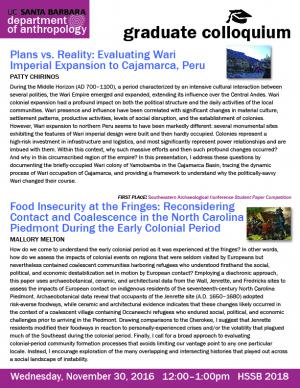Event Date:
Wednesday, November 30, 2016 - 12:00pm to 1:00pm
Event Location:
- HSSB 2018
Plans vs. Reality: Evaluating Wari Imperial Expansion to Cajamarca, Peru
Patty Chirinos
During the Middle Horizon (AD 700-1100), a period characterized by an intensive cultural interaction between several polities, the Wari Empire emerged and expanded, extending its influence over the Central Andes. Wari colonial expansion had a profound impact on both the political structure and the daily activities of the local communities. Wari presence and influence have been correlated with significant changes in material culture, settlement patterns, productive activities, levels of social disruption, and the establishment of colonies. However, Wari expansion to northern Peru seems to have been markedly different: several monumental sites exhibiting the features of Wari imperial design were built and then hardly occupied. Colonies represent a high-risk investment in infrastructure and logistics, and most significantly represent power relationships and are imbued with them. Within this context, why such massive efforts and then such profound changes occurred? And why in this circumscribed region of the empire? In this presentation, I address these questions by documenting the briefly-occupied Wari colony of Yamobamba in the Cajamarca Basin, tracing the dynamic process of Wari occupation of Cajamarca, and providing a framework to understand why the politically-savvy Wari changed their course.
Food Insecurity at the Fringes: Reconsidering Contact and Coalescence in the North Carolina Piedmont During the Early Colonial Period
Mallory Melton
How do we come to understand the early colonial period as it was experienced at the fringes? In other words, how do we assess the impacts of colonial events on regions that were seldom visited by Europeans but nevertheless contained coalescent communities harboring refugees who understood firsthand the social, political, and economic destabilization set in motion by European contact? Employing a diachronic approach, this paper uses archaeobotanical, ceramic, and architectural data from the Wall, Jenrette, and Fredricks sites to assess the impacts of European contact on indigenous residents of the seventeenth-century North Carolina Piedmont. Archaeobotanical data reveal that occupants of the Jenrette site (A.D. 1650-1680) adopted risk-averse foodways, while ceramic and architectural evidence indicates that these changes likely occurred in the context of a coalescent village containing Occaneechi refugees who endured social, political, and economic challenges prior to arriving in the Piedmont. Drawing comparisons to the Cherokee, I suggest that Jenrette residents modified their foodways in reaction to personally-experienced crises and/or the volatility that plagued much of the Southeast during the colonial period. Finally, I call for a broad approach to evaluating colonial-period community formation processes that avoids limiting our vantage point to any one particular locale. Instead, I encourage exploration of the many overlapping and intersecting histories that played out across a social landscape of instability.
November 28, 2016 - 4:39pm




